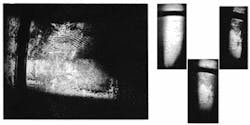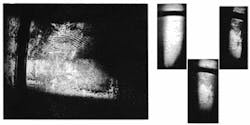Software builds fingerprint images
In legal cases where criminal convictions are to be based on fingerprints, forensic technicians must accurately collect, document, and analyze fingerprint evidence. In many cases, however, fingerprint evidence must be taken from curved or angled surfaces, which makes it extremely complicated to obtain a one-dimensional fingerprint image. For comparison purposes, fingerprints must contain as much detail as possible in a flat image.
Traditionally, collecting fingerprints requires dusting objects with powder to make the fingerprint visible, transferring an impression of the image to sticky tape, and then transferring the image onto clear sheets. These images are then compared with the legal agency's database of criminals' fingerprints. However, if fingerprints are collected from three-dimensional surfaces, fingerprint impressions will contain out-of-focus areas that may make it difficult to identify identification features such as whorls. To capture such images accurately requires that a number of photographs be taken and manually overlaid to produce a flat image of the fingerprint. Such methods are, however, laborious and time-consuming.
Therefore, the Wiltshire Police Fingerprint Laboratory (Devizes, Wiltshire, England) has installed a digital imaging system that captures fingerprint images from three-dimensional objects without removing or copying the images (see figure).
Software is used to automatically overlay the fingerprint images to form one complete detailed image.
To visualize fingerprints, the Fingerprint Laboratory uses high-intensity light sources to make fingerprint impressions fluoresce and, if necessary, backlights them to get the optimum photographic conditions. Fingerprint impressions are then digitally photographed using a DCS-121 digital workstation from
Mason Vactron (Evesham, Worcestershire, England) either at the crime scene or in the laboratory.
After image capture, the workstation produces a digital negative that automatically flags any alterations made to it, prints out hard copies of black fingerprints on a white background, makes working digital copies of the validated digital negative fingerprint image, and stores the original as bmp or TIFF files. Digital fingerprint files are then processed by Auto-Montage software from Syncroscopy (Cambridge, England) to scan the image. The workstation then combine the most in-focus regions from a series of partially focused fingerprint images taken at different focal lengths and automatically produces a completely focused final image that can be used for identification purposes.
Auto-Montage also can create a depth map showing which parts of fingerprint images were used to generate the final image. This map is useful to explain to juries how the fingerprint images were generated. In addition, the software allows the Fingerprint Laboratory to measure features such as whorls or the length of scars or nicks. Measurements in x and y axes can then be compared with other fingerprint measurements stored in a central fingerprint database.

